Dahlia plant care is simple when you understand the key aspects. CARS.EDU.VN is here to guide you through every step, from planting to overwintering, ensuring your dahlias flourish with vibrant blooms. Uncover expert advice on nurturing these stunning flowers, including feeding schedules and pest control, for a beautiful and thriving garden. Learn about dahlia varieties, soil preparation, and common problems to keep your plants healthy and vibrant.
1. Understanding Dahlias: An Introduction
Dahlias, originally from Central America, were introduced to Europe alongside potatoes and tomatoes. Initially intended for consumption, their ornamental beauty soon took center stage. These tender plants thrive in abundant sunshine but require winter protection. While dahlia plants are readily available at garden centers during the summer, many gardeners opt to cultivate them from tubers. These tubers are potted and encouraged to grow indoors from late March to early April, before being transplanted outdoors in May, once the threat of frost has passed. Dahlias can also be propagated from rooted cuttings and seeds. In colder regions, gardeners often dig up their dahlia tubers in the autumn after the first frosts and store them indoors over the winter.
Sprouted dahlia tubers on a windowsill, ready for planting, benefit from early indoor care.
Key aspects of dahlia care include:
- Sunlight: Dahlias need at least six hours of sunlight per day.
- Soil: Fertile, moist, and well-drained soil is essential.
- Watering: Regular watering, especially during dry periods, is crucial.
- Protection: Dahlias need protection from frost and pests.
2. Essential Growing Conditions for Dahlias
2.1. Choosing the Right Location
Dahlias thrive in a sunny, sheltered location with fertile, moist, and well-drained soil. A south- or west-facing border is ideal, providing the necessary sunlight and protection from harsh weather conditions. Dahlias are adaptable when it comes to soil type. For best results, enrich the soil with organic matter such as well-rotted manure. If planting in heavy clay soil, incorporate grit into the planting hole to improve drainage. For dahlias grown in pots, use a high-quality, peat-free multi-purpose compost. Proper drainage is crucial to prevent root rot.
- Sunlight: At least 6 hours of direct sunlight daily
- Soil: Fertile, well-drained with added organic matter
- Shelter: Protection from strong winds
2.2. Soil Preparation and Planting
Before planting, prepare the soil by digging a hole that’s approximately 30cm wide. Add a bucketful of well-rotted organic matter to boost soil fertility. If you have heavy clay soil, incorporating horticultural grit at the base of the planting hole will improve drainage. When transplanting a dahlia purchased from a garden center, ensure you plant it at the same depth it was in the pot. Dahlias require ample space to grow, so plant them about 60cm apart.
| Aspect | Details |
|---|---|
| Hole Size | Approximately 30cm wide |
| Soil Amendment | Add well-rotted organic matter |
| Drainage | Incorporate horticultural grit for heavy clay soil |
| Spacing | Plant about 60cm apart |
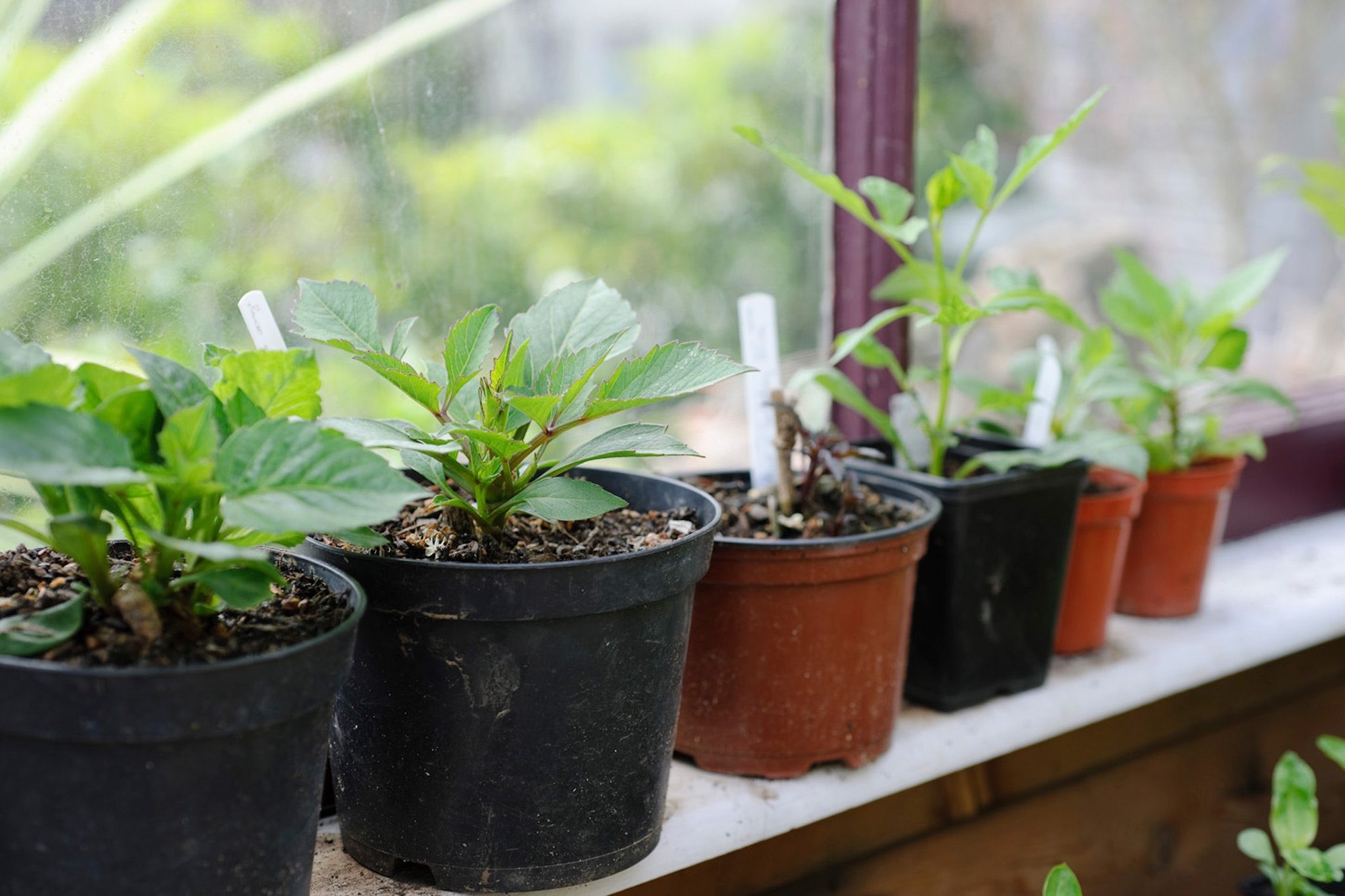
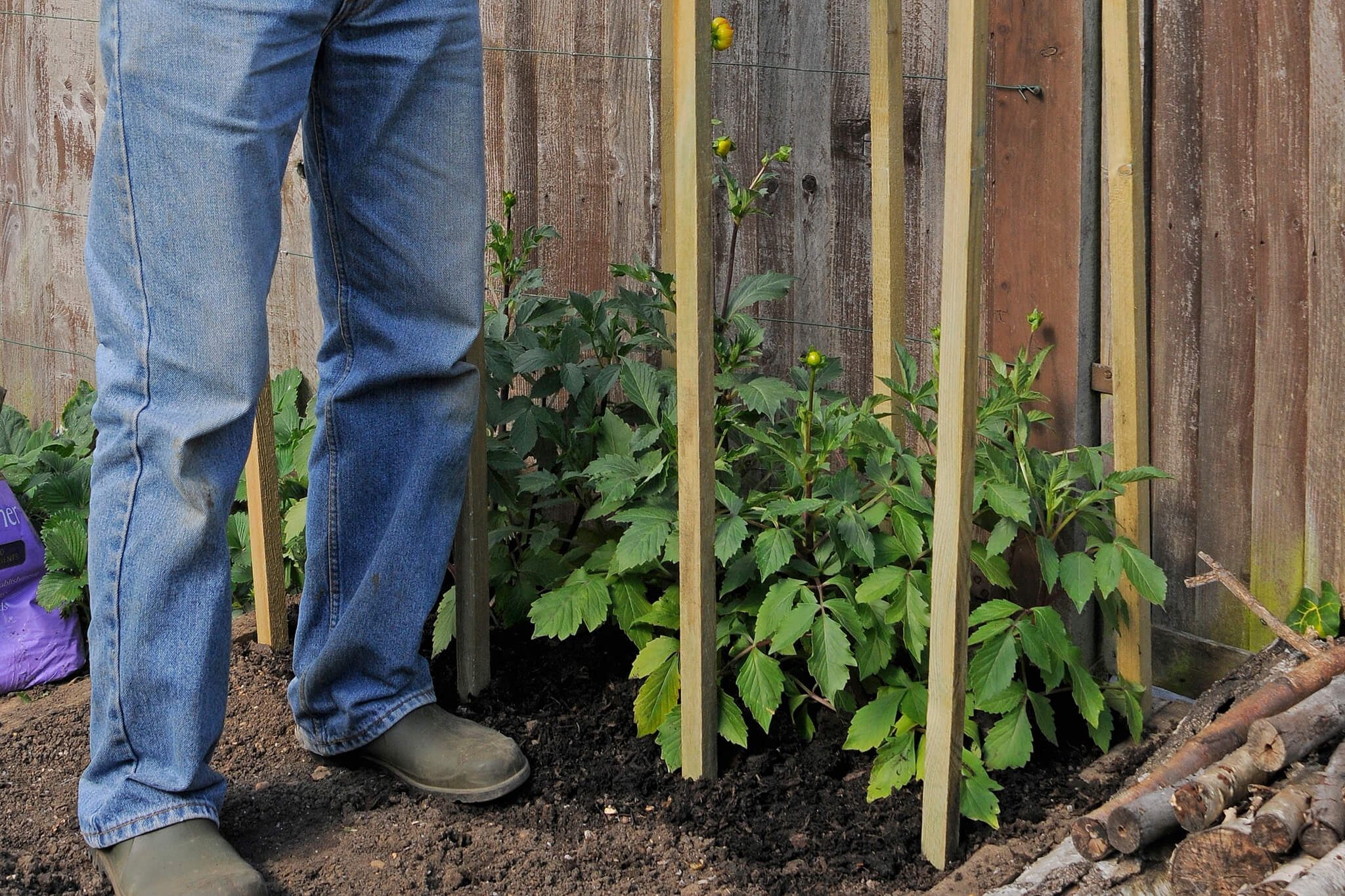
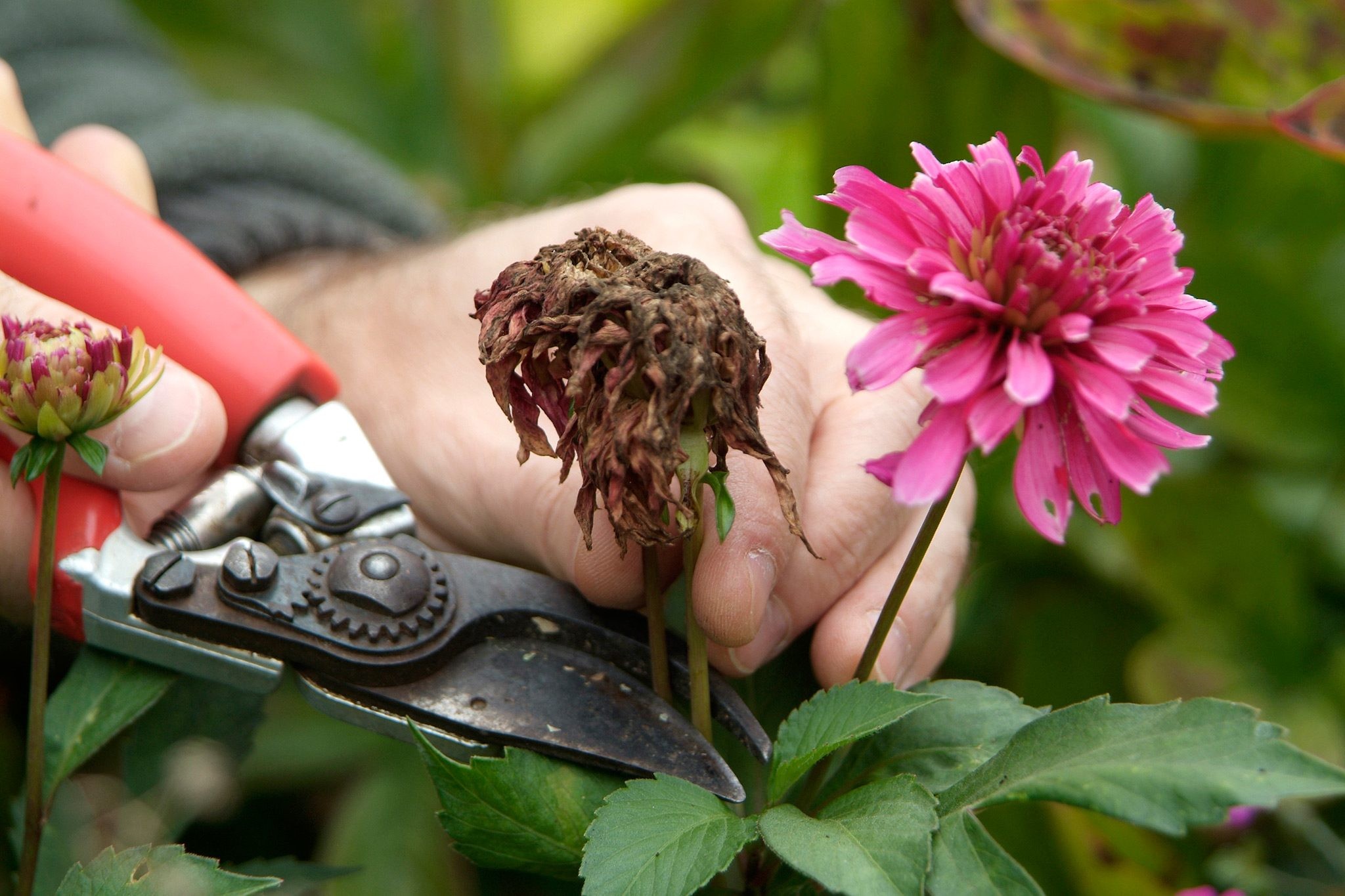
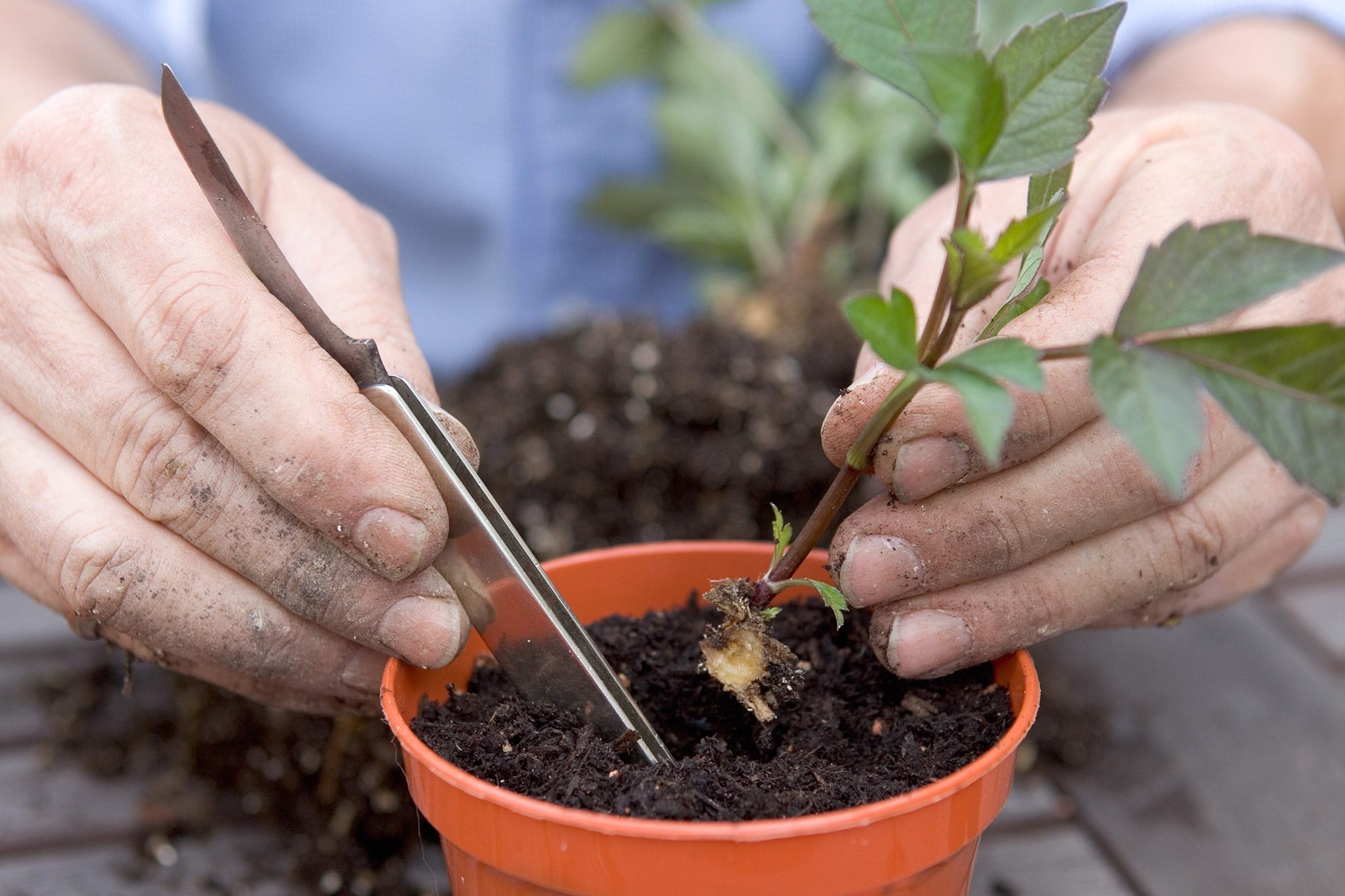

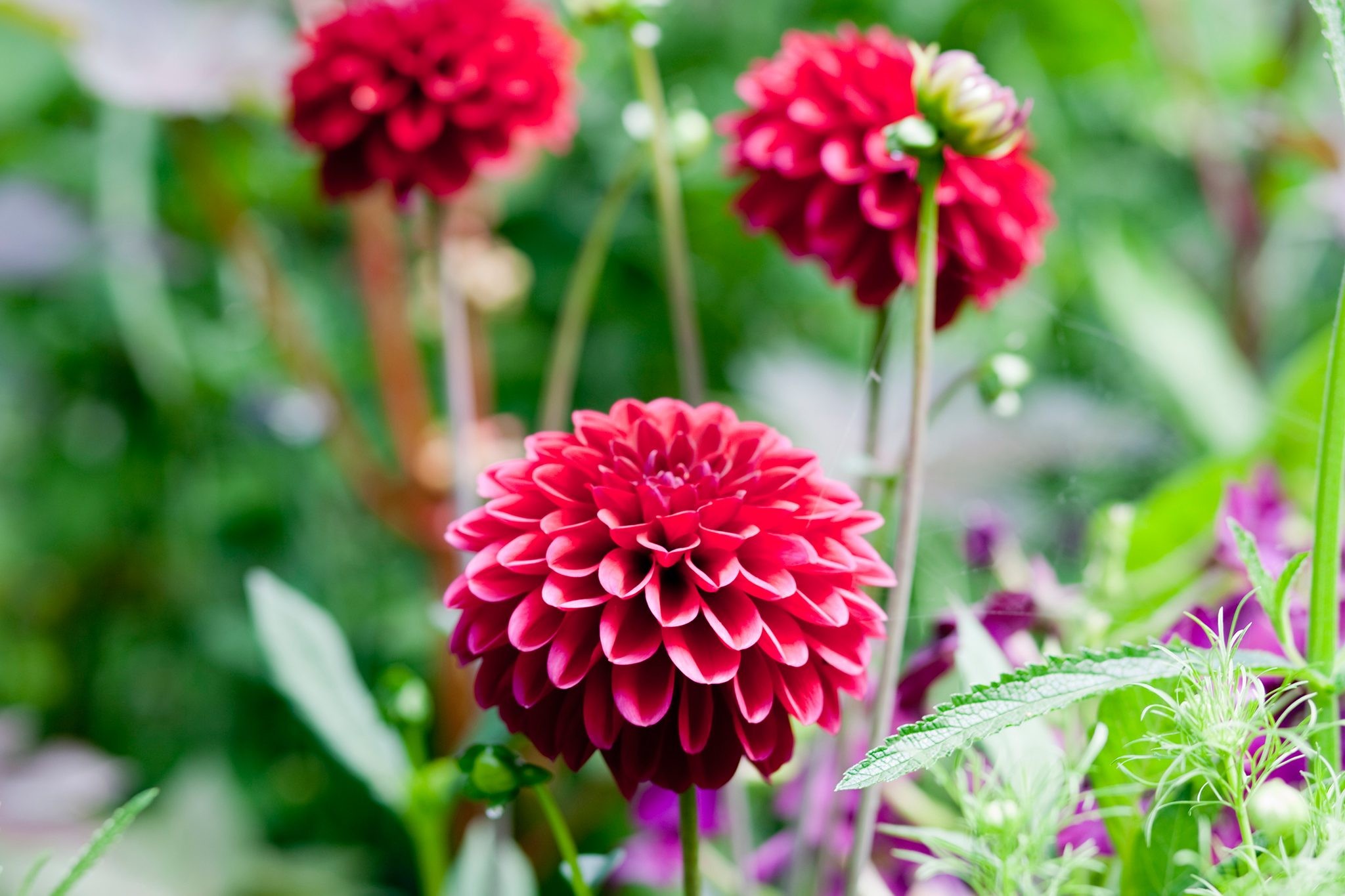
2.3. Growing Dahlias from Tubers
Dahlia tubers are typically available for purchase starting in February. Garden centers offer a decent selection, but for a wider variety, consider buying online. In early April, place your tubers in a large, shallow tray, lightly covered with compost. Alternatively, pot each tuber individually in a large plastic pot filled with multi-purpose potting compost. Position the tuber correctly (look for the old stem or a new shoot to identify the top), ensuring it sits just below the soil surface. Water thoroughly, allowing any excess water to drain away.
| Step | Description |
|---|---|
| Timing | Early April |
| Preparation | Place tubers in a tray or pot individually |
| Positioning | Ensure the tuber sits just below the soil surface, with the shoot facing upwards |
| Watering | Water thoroughly and allow excess water to drain |
Place the tubers in a bright, frost-free location such as a greenhouse, cold frame, porch, or windowsill, and keep the compost consistently moist. New shoots should begin to emerge approximately five weeks after planting. By the time the threat of frost has passed in May, they should have developed into bushy plants ready for transplanting into the garden.
3. Buying Dahlias: Key Considerations
3.1. When and Where to Buy
Dahlia tubers are available for purchase starting in February. While many garden centers offer a good selection, purchasing online from nurseries and specialist growers can provide access to a wider range of varieties. Consider buying rooted tubers in early spring or more established plants from April to June if you missed the initial window.
Where to Buy Dahlias Online:
- Crocus: Offers a vast range of colors and shapes, with discounted prices for multiple collections.
Crocus - Thompson & Morgan: Provides access to the new 2022 range of varieties, including unique options like ‘Electro Pink’ and ‘Lubega Power Tropical Punch.’
Thompson & Morgan - de Jager: Established bulb specialists with an impressive collection of dahlia tubers in various colors and flower shapes.
de Jager - Dobies: Offers a great selection with special offers and discounts on specific collections.
Dobies - Sarah Raven: Features a large collection in a range of colors and shapes.
Sarah Raven
3.2. Selecting the Right Type
When buying dahlias, keep the following in mind:
- Size: Dahlias come in various sizes, from dwarf types suitable for bedding displays to medium-sized plants perfect for pots, and large varieties best suited for borders or cutting patches. Always check the plant’s ultimate size before purchasing.
- Growing Conditions: Ensure you have the right conditions for growing dahlias, including a sheltered, sunny location.
- Tuber Quality: If buying tubers at a garden center, choose those that are large and plump, with no signs of rot or mold.
4. Planting Dahlias: A Step-by-Step Guide
4.1. Timing and Hardening Off
In mid to late May, once the risk of frost has passed, dahlia plants can be transplanted into the garden. Before doing so, it may be necessary to remove some shoots from the tuber, leaving approximately five remaining. While this might seem harsh, it encourages the growth of bushy plants that will produce abundant flowers. The removed shoots can be used to create basal cuttings.
Before planting your dahlias outdoors, harden off the plants by gradually acclimatizing them to outdoor conditions. Place them outside during the day and bring them back inside at night for about a week. This process helps the plants adjust to the change in environment and reduces transplant shock.
| Step | Description |
|---|---|
| Timing | Mid to late May, after the last frost |
| Shoot Removal | Remove some shoots, leaving about five |
| Hardening Off | Acclimatize plants to outdoor conditions by placing them outside during the day for about a week |
4.2. Planting Procedure
Dig a planting hole that is approximately 30cm across and add a bucketful of well-rotted organic matter to increase soil fertility. If your soil is heavy clay, incorporate horticultural grit at the base of the planting hole to improve drainage. Protect the new shoots from slugs and snails. If planting a dahlia purchased from a garden center, plant it at the same depth it was in the pot. Dahlias need plenty of room to grow, so space them approximately 60cm apart.
4.3. Providing Support
Once planted, provide your dahlia with support, unless it is a dwarf variety. Dahlias grow rapidly and tend to flop, especially when the flower heads are large. Install a sturdy stake or bamboo canes at all four corners of the plant. These will become concealed as the plant grows. Tie the new growth to the support every couple of weeks.
If planting dahlias in a pot, choose a large container that is at least 30cm wide and deep. Fill the pot with multi-purpose compost mixed with organic matter such as well-rotted manure. You can also add slow-release plant food at this time. Plant the dahlia at the same depth it was in its original pot.
Dahlias growing among supports, ensuring they remain upright and healthy throughout the season.
5. Caring for Dahlias: Essential Maintenance
5.1. Encouraging Bushy Growth
Once the plant reaches a height of approximately 20cm, encourage more flowering side shoots by pinching out the main growing tip. Remove the main shoot (located in the center of the plant, growing upright) down to the top pair of leaves. Use a sharp knife or your thumb and forefinger to accomplish this.
| Aspect | Description |
|---|---|
| Timing | When the plant reaches 20cm in height |
| Technique | Pinch out the main growing tip down to the top pair of leaves |
| Purpose | Encourage more flowering side shoots |
5.2. Regular Maintenance
Tie in new growth to the stake every week or so. Fertilize your dahlias every two weeks with a high-potash feed, such as tomato feed, to encourage continuous flowering. Water the plants thoroughly once a week. Deadheading dahlias is crucial for prolonging flowering. Distinguishing between buds and spent flower heads can be tricky; buds are round, while spent flower heads are more pointed. Remove the entire flowering stem.
5.3. Cutting Dahlias for Display
If you’re growing dahlias for cut flowers, harvest them when they are fully open. Dahlia expert Michael Mann emphasizes three golden rules for caring for dahlias: regular feeding, consistent watering, and diligent deadheading.
Deadheading spent dahlia flowers encourages more blooms and extends the flowering season.
6. Overwintering Dahlias: Protecting from Frost
6.1. Lifting and Storing Tubers
In many regions, dahlias will not survive the winter if left in the garden, especially if conditions are frosty or wet. Therefore, it is best to lift the tubers once the foliage has been blackened by frost. Cut the stems back to approximately 12cm, then gently lift the tuber with a garden fork, removing any soil with your fingers. Place the tubers upside down in a newspaper-lined tray and allow them to dry out for a couple of weeks in a dry location.
| Step | Description |
|---|---|
| Timing | After the first frost, when foliage is blackened |
| Preparation | Cut stems back to 12cm |
| Lifting | Gently lift the tuber with a garden fork |
| Drying | Place tubers upside down in a newspaper-lined tray to dry for a couple of weeks |
6.2. Storing Over Winter
Once dry, place the tubers in a cool, frost-free location in a shallow tray filled with dry compost or horticultural sand. Do not water them. They do not require light during this time, making a dark garage an ideal storage space. Leave them undisturbed until it’s time to pot them up again in late March or early spring.
If you reside in a mild area with well-drained soil, or if you lack the space to lift and store dahlia tubers, you can cover the soil with a thick layer of mushroom compost or straw to insulate the tubers from frost. In spring, simply remove the excess compost.
7. Propagating Dahlias: Expanding Your Collection
7.1. Dividing Tubers
Dahlia tubers that are of a good size can be divided in spring. Press the tubers down onto a tray of shallow compost and allow them to begin growing in a greenhouse or a sunny room. Keep the compost warm and moist. Once the tubers start producing shoots, divide them using a clean, sharp knife, ensuring that each section has at least one shoot and set of roots. Pot the divisions and grow them on for planting out once all danger of frost has passed.
7.2. Taking Cuttings
Dahlias can also be easily propagated by taking basal cuttings in spring. Each tuber can yield approximately five new plants for free that will flower in summer. You can also purchase rooted cuttings online in spring. These will produce smaller plants in their first year, making them suitable for pots, but they will still flower well.
A gardener taking dahlia cuttings, a great way to propagate new plants from existing tubers.
7.3. Growing from Seed
It is also possible to grow dahlias from seed, though this method may not produce plants identical to the parent.
8. Common Problems and Solutions
8.1. Pests
Dahlias are susceptible to attacks from earwigs, which consume their foliage, buds, and flowers. Create earwig traps by inserting a garden cane into the soil and placing an upturned garden pot filled with straw on top. During the day, the earwigs will retreat to the pot, allowing you to dispose of them. Slugs and snails also adore dahlias, particularly the new growth. Planting out plants once they have reached a decent size helps, as does surrounding the plant with a copper ring. You can also scatter organic slug pellets, which are harmless to wildlife. Capsid bugs can also pose a problem.
A gardener making an earwig trap, a simple yet effective way to protect dahlia plants from pests.
8.2. Diseases
Dahlia leaves can curl and become distorted due to various reasons, including aphid and red spider mite infestations, mosaic virus, and botrytis. Inspect the plant thoroughly for signs of invertebrates and remove them, along with any affected leaves. The plant should recover. If there are no signs of invertebrates, mosaic virus or botrytis may be the cause. Unfortunately, there is no cure for these diseases, so you will need to destroy the plant.
8.3. Environmental Issues
If a dahlia stem snaps off in the wind, more stems will grow from the base if the tubers are healthy. Water the plant well and prune the severed stem down to a pair of leaf nodes. Be patient and allow the plant to recover.
9. Varieties of Dahlias: Exploring the Options
9.1. Single Dahlias
Single dahlias, such as ‘Joe Swift’ and ‘Bishop of Llandaff,’ feature a single ring of petals surrounding a central disc. These dahlias are particularly attractive to pollinators.
9.2. Cactus Dahlias
Cactus dahlias, including ‘Doris Day’ and ‘Ryecroft Pixie,’ have fully double blooms with very narrow petals that curve outward from the tip to the base. They vary in size from miniature to giant.
9.3. Semi-Cactus Dahlias
Semi-cactus dahlias, such as ‘Dame Deirdre,’ ‘Pink Preference,’ and ‘Vulcan,’ have fully double, fluffy-looking flowers. The petals have a broader base than cactus dahlias and are rolled for approximately half of their length.
9.4. Pompon Dahlias
Pompon dahlias, like ‘Moor Place’ and ‘Franz Kafka,’ are perfect spheres formed of petals that curve inward. Their flowers are smaller than those of ball dahlias.
9.5. Ball Dahlias
Ball dahlias, including ‘Jomanda’ and ‘Aurora’s Kiss,’ are larger than pompon dahlias and feature a spiral arrangement of curved petals that form a ball or a slightly flattened sphere.
9.6. Waterlily Dahlias
Waterlily dahlias, such as ‘Kilburn Rose’ and ‘Taratahi Ruby,’ resemble waterlily flowers with broad, shallow double flowers shaped like a saucer, with curved or flat petals.
9.7. Anemone Dahlias
Anemone dahlias, like ‘Lambada,’ have a unique appearance with tubular florets in their center, surrounded by at least one ring of flatter petals on the outside.
9.8. Decorative Dahlias
Decorative dahlias, such as ‘Checkers’ and ‘David Howard,’ have fully double, slightly flat, and broad petals, often with a blunt end and no central disc. They are the largest of all dahlias, with flowers reaching up to 25cm in diameter.
9.9. Collarette Dahlias
Collarette dahlias feature large petals that surround a ‘collar’ of smaller petals around a central disc. Examples include ‘Chimborazo’ and ‘Yankee Doodle Dandy.’
_Dahlia ‘Arabian Night’, a stunning example of the diverse range of dahlia varieties available.*
10. Dahlias by Flower Color: A Colorful Palette
Dahlias are available in a vast array of colors, allowing you to select varieties that perfectly complement your garden’s aesthetic.
| Color | Popular Varieties |
|---|---|
| Red | Arabian Night, Preference |
| Pink | Pink Preference, Kilburn Rose |
| Yellow | Doris Day, Joe Swift |
| Purple | Bishop of Llandaff, Franz Kafka |
| White | Aurora’s Kiss, Moor Place |
| Multi-Color | Checkers, Yankee Doodle Dandy |
11. Frequently Asked Questions About Dahlia Plant Care
11.1. What should I do if my dahlia stem snaps off in the wind?
Don’t worry if a dahlia stem snaps off in the wind. Provided the tubers are healthy, more stems will grow from the base. Water the plant thoroughly and prune the severed stem down to a pair of leaf nodes. Be patient and allow the plant to recover.
11.2. What size pot is best for growing dahlias?
The ideal pot size for growing dahlias depends on the variety. Generally, a pot with a height and diameter of around 35cm is sufficient for a dahlia up to 1m in height. Plant one dahlia tuber per pot and keep it well-watered. Remember to stake your plant and avoid growing very tall dahlias in pots.
11.3. What should I do if my dahlia doesn’t have any tubers?
Dahlias grown from seed typically develop a tuber by the end of the growing season. However, if there is no tuber, dig up the rootball and pot the dahlia. Water it to help it settle in. Keep it in an unheated greenhouse or similar environment where it can continue growing without the threat of frost. Water sparingly to prevent the compost from drying out, and then replant after the frost has passed in spring. It should develop tubers the following year.
11.4. What causes dahlia leaves to curl and distort?
Dahlia leaves can curl and become distorted for several reasons, including attacks from aphids and red spider mites, mosaic virus, and botrytis. Inspect the plant thoroughly for signs of invertebrates and remove them, along with any affected leaves. If there are no signs of invertebrates, mosaic virus or botrytis may be the cause, and the plant will need to be destroyed.
11.5. How often should I water my dahlias?
Water dahlias thoroughly once a week, especially during dry periods. Ensure the soil remains consistently moist but not waterlogged.
11.6. When should I fertilize my dahlias?
Fertilize dahlias every two weeks with a high-potash feed, such as tomato feed, to promote continuous flowering.
11.7. How do I protect dahlias from slugs and snails?
Protect new shoots from slugs and snails by surrounding the plant with a copper ring. You can also scatter organic slug pellets that are safe for wildlife.
11.8. Can I grow dahlias in containers?
Yes, dahlias can be grown in containers. Choose a large container that is at least 30cm wide and deep and fill it with multi-purpose compost mixed with organic matter.
11.9. When is the best time to plant dahlia tubers?
The best time to plant dahlia tubers is in early April, after starting them indoors in a frost-free location. Transplant them into the garden in mid to late May, once the risk of frost has passed.
11.10. How do I deadhead dahlias properly?
Deadhead dahlias regularly to prolong flowering. Distinguish between buds and spent flower heads; buds are round, while spent flower heads are more pointed. Remove the entire flowering stem.
CARS.EDU.VN is your ultimate resource for all things automotive, but we also believe in enriching your life in every aspect, including gardening. Just as we provide detailed guidance on car maintenance, we offer expert tips for nurturing beautiful dahlias. From diagnosing car troubles to cultivating a vibrant garden, we’ve got you covered.
Facing challenges with your dahlia plants? Need reliable advice on plant care? Visit CARS.EDU.VN for more detailed guides and expert solutions. Our comprehensive resources are designed to help you succeed in every endeavor, from maintaining your vehicle to creating a thriving garden.
Contact Information:
Address: 456 Auto Drive, Anytown, CA 90210, United States
WhatsApp: +1 555-123-4567
Website: cars.edu.vn